My journey toward Denmark started on Monday morning as I left Dortmund. This weekend excursion in the Ruhr area was not really the goal of this trip; it was only a jumping-off point toward destinations further north.
In the last two years I've been severely cutting back on flying vacations, because I've become much more aware of how environmentally damaging jet engines are. Back in December of 2019 I did a snowboarding trip to Kvitfjell and Hafjell, Norway, and when I planned that trip I had wanted to stay entirely on the ground using trains and ships to reach my destination. Unfortunately, I didn't have enough days off from work to do this, and so begrudgingly had to work in short round-trip flights between Hamburg and Oslo to make everything fit in the week off I had. I still promised myself that sometime in 2020 I would take a trip all the way up to somewhere in Scandinavia and back without ever seeing the inside of a plane. The pandemic put this in doubt for a while, but I was thankfully able to take this trip while the virus' spread had temporarily slowed down.
Monday, September 21, 2020
For some reason there was no breakfast on that morning at the a&o hostel in Dortmund, so I just packed up my stuff, checked out, and got myself some kind of sandwich in the train station at one of those bakery chains one usually finds in German train stations.
Today's final destination was Odense, Denmark. This trip was going to last all of seven hours. This was one of the reasons I spent the weekend in the Ruhr area; going straight from Stuttgart to Odense in one day would have been excruciatingly long. This journey consisted of three train trips. The first was almost three hours from Dortmund to Hamburg on a German ICE. After a bit of a layover in Hamburg, the second train was a slower IC operated by DSB, Denmark's national railway, which I would take from Hamburg to Kolding, Denmark.
The Hamburg-Kolding trip took three hours, and it included a stop at the border for passport checks. While Denmark and Germany are both Schengen countries, and thus should be without border controls between them, it looks like the pandemic has changed the state of affairs somewhat. Danish border police entered the train and checked everyone's passports. I was just a little bit worried that my US passport would be a problem for them, because I know most countries are turning away Americans because of the pandemic. Fortunately they let me through without any issues. I think this was because I was arriving by train from Germany and not stepping off a plane directly from the States.
Denmark is a small country which is comprised partially of a peninsula protruding from the European mainland called Jutland (Danish Jylland) as well as several islands. Jutland is where most of the trip from Hamburg to Kolding happened. This day's destination, Odense, is on an island called Funen (Danish Fyn). The capital and largest city, Copenhagen (København), is on another, bigger, island called Sealand (Sjelland).
The third and final train of the day pulled out of Kolding, crossed over a long bridge connecting the Jutland mainland with the island of Funen, and after about an hour brought me into Odense's central station. By now it was definitely time for lunch and I was hungry. I found a pretty good restaurant in the station called The Food Stall (yes, in English).
The Food Stall was the kind of place where you could make your own salad--I like restaurants like this--although thanks to the pandemic, you can't actually make it yourself but must dictate what you want to someone behind the counter. I can't remember what I had there, just that it was good but unsatisfying. I should've piled more on the plate.
I also stopped at an ATM to get some cash. Denmark is not in the Eurozone, in fact none of the Nordic countries save Finland are. Each country has its own currency called "krone" meaning "crown." Exchange rates vary, so one country's krone won't be exactly worth the same as another's.
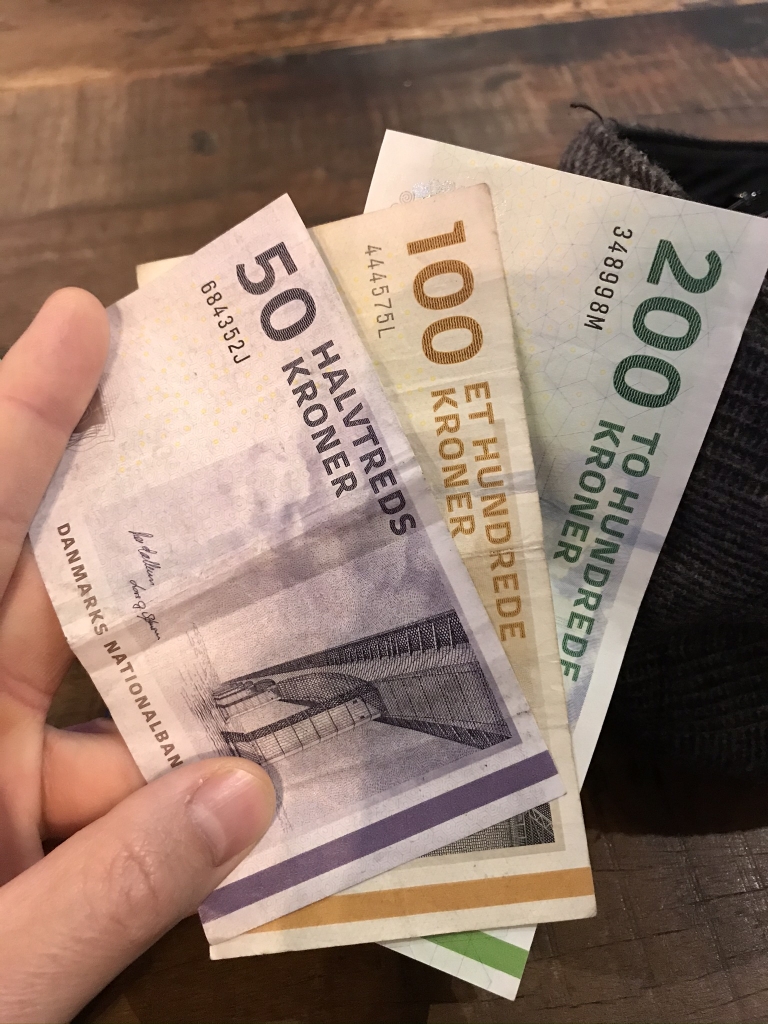
At this point in time, 10 Danish Kroner were worth about $1.60.
Outside the train station I noticed a sign on a building across the street, telling me in English that Odense was the home of Hans Christian Andersen, the fairytale writer, and that I should follow a trail of footsteps on the ground. OK, that seemed like a nice diversion on an afternoon with little to do. There was a trail of footsteps trailing around this part of the city, impressed into the sidewalks and easy to notice if you already knew they were there. I followed them around for awhile, around one corner after another, until finally arriving at a construction site. Andersen's house, perhaps, closed for renovation? I thought. I didn't know where I was at the time, but since returning home I've painstakingly followed the footsteps on Google Maps Street View. I had not reached Andersen's house but that was indeed where the footsteps ultimately led. They may have seemed to dead-end at that construction site, but if I had walked a little farther I would have found they continued eventually and ended up at the historic house. But I didn't know that back then, so all I could do was follow the footsteps backward to where I started.
I stayed at a place called Danhostel that night and it was attached to the train station. I'm still not sure if this place was a hotel or a hostel. Sure, it had "hostel" in the name, but it wasn't listed on hostelworld.com. I had found it on hotels.com where I paid over $50 for a private room which was all that seemed to be available. That's a bargain for a hotel but exactly what I'd expect for a private room in a hostel. But I don't recall seeing any dorms in the building. I checked in here after following the footsteps in reverse from the Andersen house to the train station.
Danish quirk #1: The electrical wall sockets are unlike what you find in any other country in the world. This one little country has its own style of wall socket.

It's not a problem though; any other two-pronged plug or adapter from anywhere in Europe will fit it.
After checking in and leaving my backpack behind, I set out to go find good things to eat and drink in Odense. First I stopped at a coffee place across the street from the train station. I read somewhere, I can't remember where, that Danes drink more coffee than anyone else in the world. I can believe that, because throughout both Odense and Copenhagen I found more big nationwide coffee restaurant chains than one usually finds anywhere else. They were clearly Denmark-based chains because I don't recall seeing any Espresso House or Joe & The Juice locations in any country further south. I did see some in Sweden, but that was it.
I don't remember the name of the place I stopped at and it's not on Google Maps. What I do remember was the slight frustration caused by the artificial sweetener dispenser. That would be Danish quirk #2: artificial sweetener comes in extremely tiny tablets which are even tinier than the sweetener tablets one finds in other European countries. And, they are often found in little plastic dispensers which almost never work correctly. Seriously, all but one of these dispensers I tried to use were jammed or broken in some way, and I had to open it up and gently pick a couple tablets out of it.
The first pub I stopped at was an Irish pub, because I have to stop at an Irish pub in every city I visit. This one was called Ryan's. I didn't have an Irish beer though, because I wanted to have my first Danish beer.
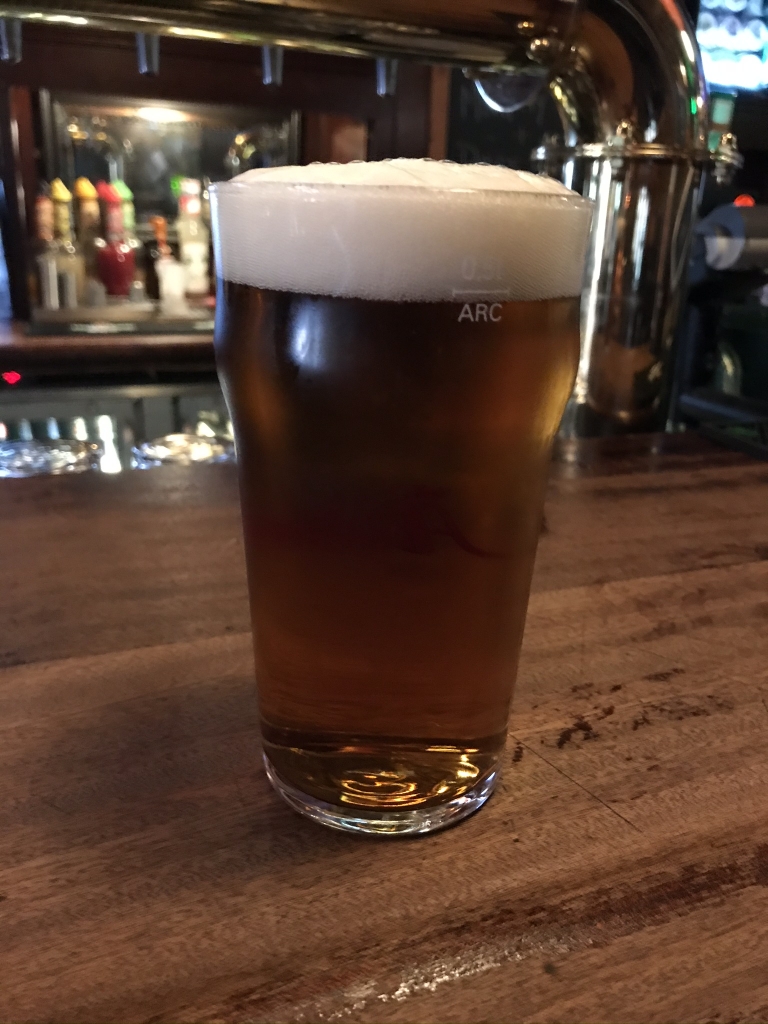
50cl of Odense Classic at Ryan‘s Irish Pub. This was a good lager I would have a few more times during this trip.
I also had a great Irish Coffee at Ryan's. They even made it with the chocolate sprinkles.
As it was getting later in the day, I went further into the center of town, where, just like nearly anywhere else in Europe, were many central squares with historic buildings around them.
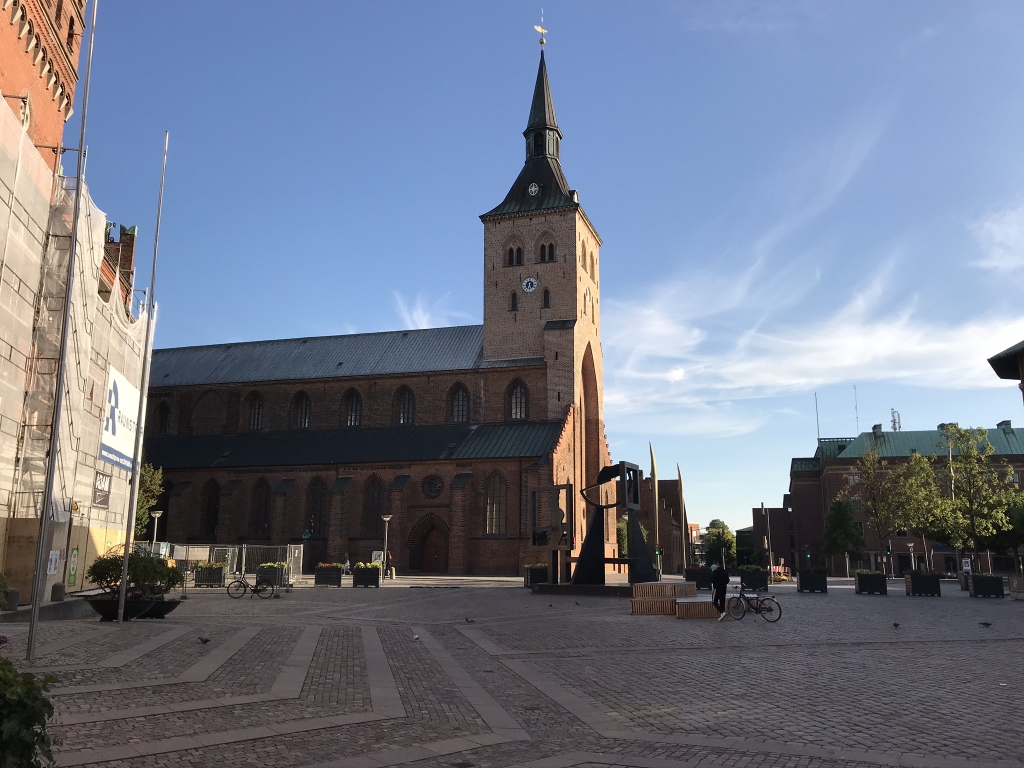
Next stop was for dinner at an upscale place called Café Vivaldi. To eat I had a green salad with salmon. I accompanied this with a 50cl glass of Jacobsen Special Brown. That beer was good but strong and bitter, so had to be slowly sipped, which I thought was nice.
While slowly making my way back to the hotel, I made another stop to sample even more Danish brews. This establishment was called Froggy‘s Café. First I drank 50cl of Tuborg Pilsner and thought it was delicious. Good enough to take more home, because later in this trip I bought a six-pack of it to bring back. Finally, since I was getting a little full, I only had 25cl of the last one of the night: Carlsberg Original 1883. I thought that was even better than the Tuborg.
Tuesday, September 22, 2020
Danhostel served one of the better breakfasts I've had on this trip. It was a self-service buffet with all the good stuff I like from a European hotel: müsli (yes!), cold-cut deli meat, fresh fruits as well as cucumbers and tomatoes...after that I got a coffee from Joe & The Juice in the train station next door and had to decide what to do with the morning.
I only had time to do one thing in Odense that morning, with my train to Copenhagen taking off at 12:57. I decided to go with the railway museum (Jernbanemuseum) since not only am I really interested in trains but it's a topic I've been trying to cover often on this blog. This particular museum is dedicated to the history of railways in Denmark. Kind of like Train World in Brussels, which I visited last year, but while that museum focused specifically on passenger rail, throughout all Europe, this one covered both passenger and freight rail, and only within Denmark.
I spent at least two hours in the Railway Museum and took a great many pictures. Some of the highlights follow.
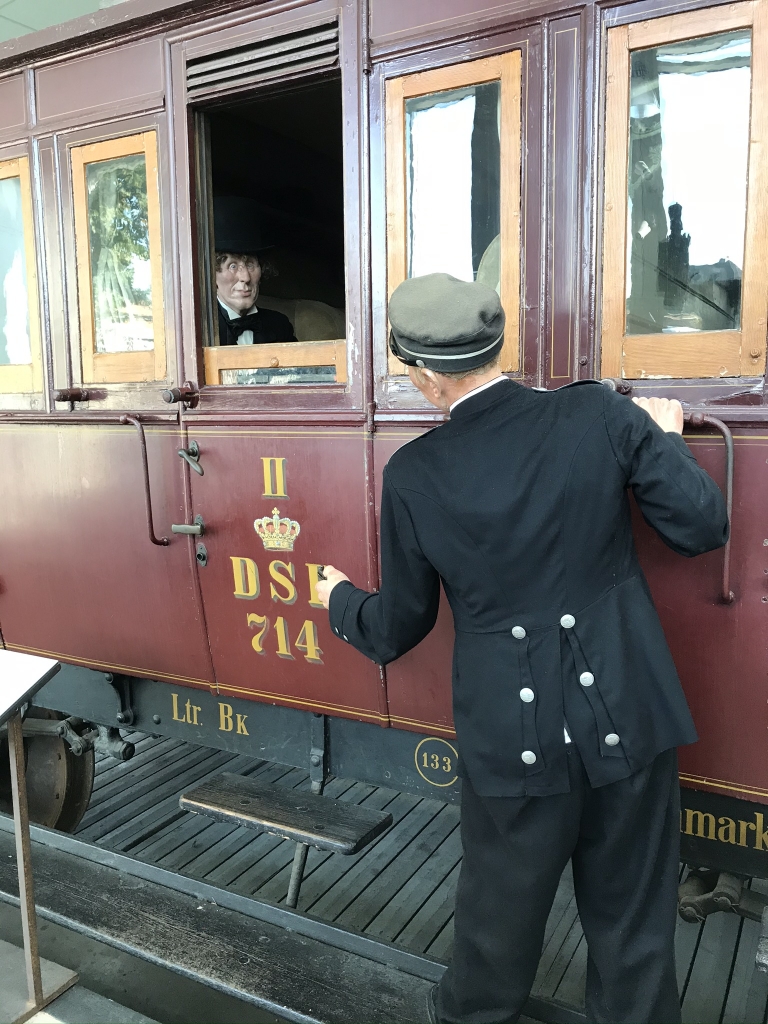
This is an early passenger car from the 1840s. That's supposed to be Hans Christian Andersen you see sitting inside. Climbing along the outside of the car is the conductor. It seems that in those early days, there were no center aisles or corridors, just a bunch of compartments whose only exits were to the outside, so the only way the conductors could check your ticket was by climbing along the side of the train. They even had to do this as the train was moving. This was dangerous, of course, but how fast did trains go back then?
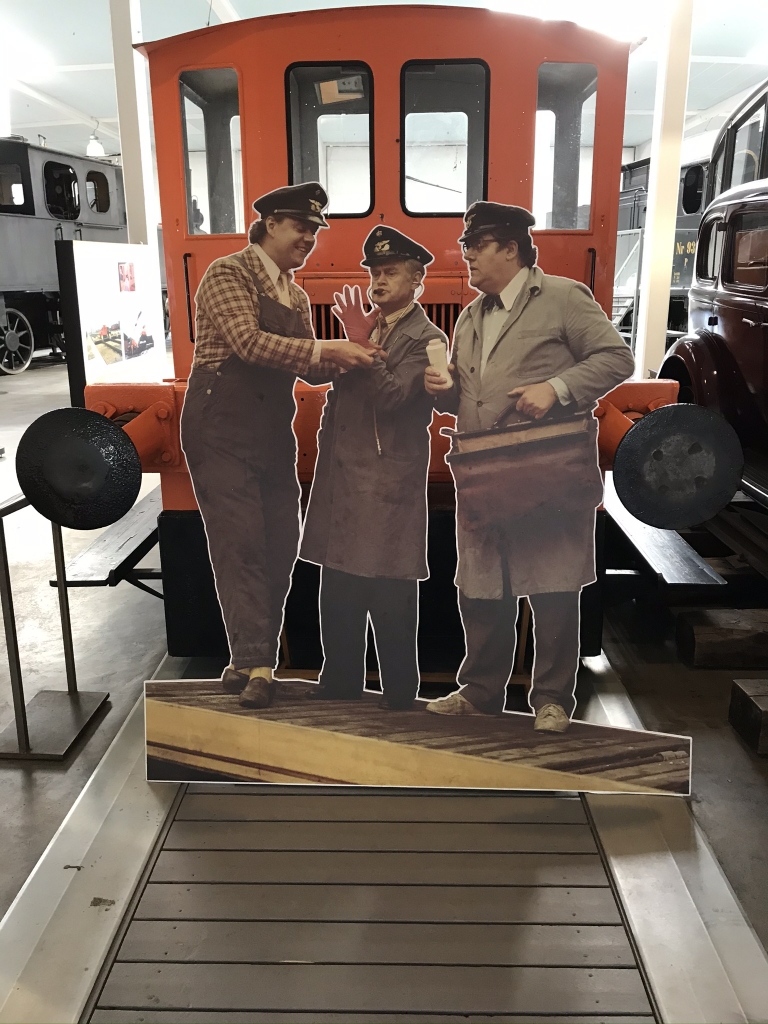
Those of us who aren't Danish won't recognize these guys. That's the Olsen Gang (Olsen-banden) who were the central characters of a series of wildly popular (in Denmark) comedy films in which small-time crook Egon Olsen and his two sidekicks hatch hare-brained illegal get-rich-quick schemes which usually go hilariously wrong. 1975's The Olsen Gang on Track (Olsen-banden på sporet) revolved around hijacking a train transporting gold bars. This film, because of its plot, unintentionally serves as a detailed portrait of Danish rail transport in the 1970s. The orange vehicle you see here, Tractor 57, was used in the film.
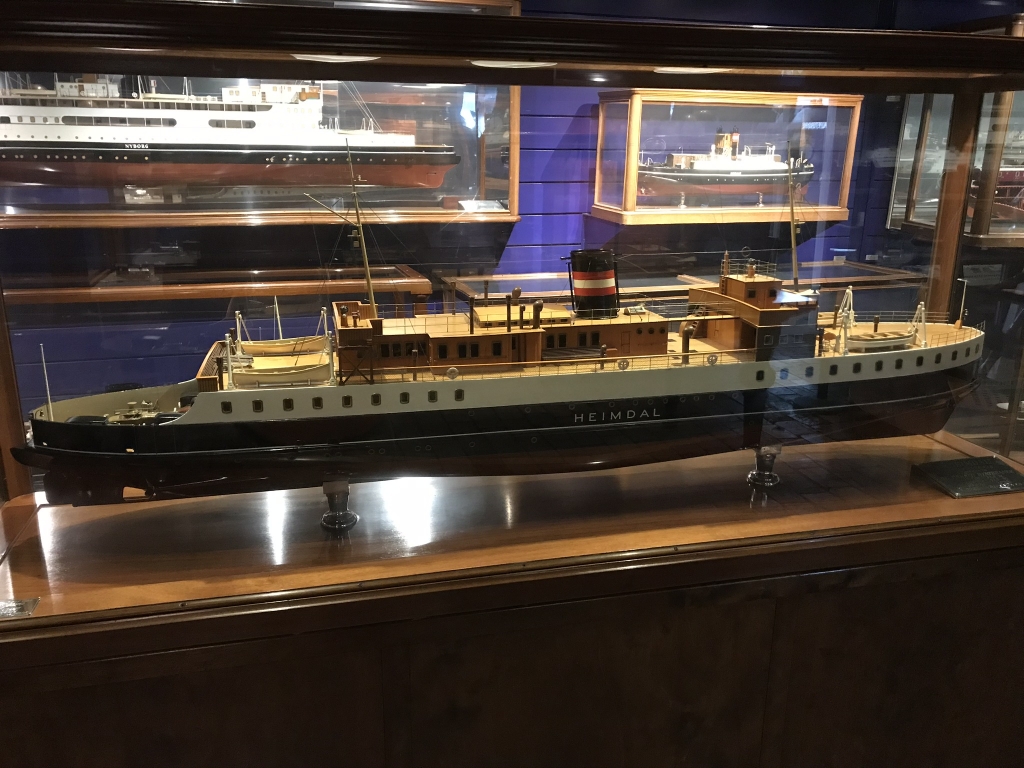
This is from an exhibition about rail ferry ships, a necessity in a country that is largely made up of islands. Some of these ships were named after places, others for royals, and others like this one took their names from Norse mythology.
Throughout another part of the museum there were many examples of rail cars that were made for every kind of freight, from acid to butter to mail to slaughtered pigs. The informational signs by all these cars explained how the then-new ability to transport these goods over long distances revolutionized so many industries and the economy in general. It really can't be understated how much the advent of rail transport upended the world economy. During the 1870s, grains grown in the United States, carried by train to seaports from American farms, saturated European markets so much that it was cheaper in Germany than domestic German grains, as Stephen S. Cohen and J. Bradford DeLong explain in Concrete Economics. One of the signs in this museum laid out some of more of the effects of this. Denmark's grain producers were devastated by all the cheap imported grain (presumably from the US, though it doesn't name the source) during that decade, and so had to ramp up meat and dairy production for export. This in turn spurred more development of the country's rail infrastructure, and the growth of Esbjerg as an international seaport.
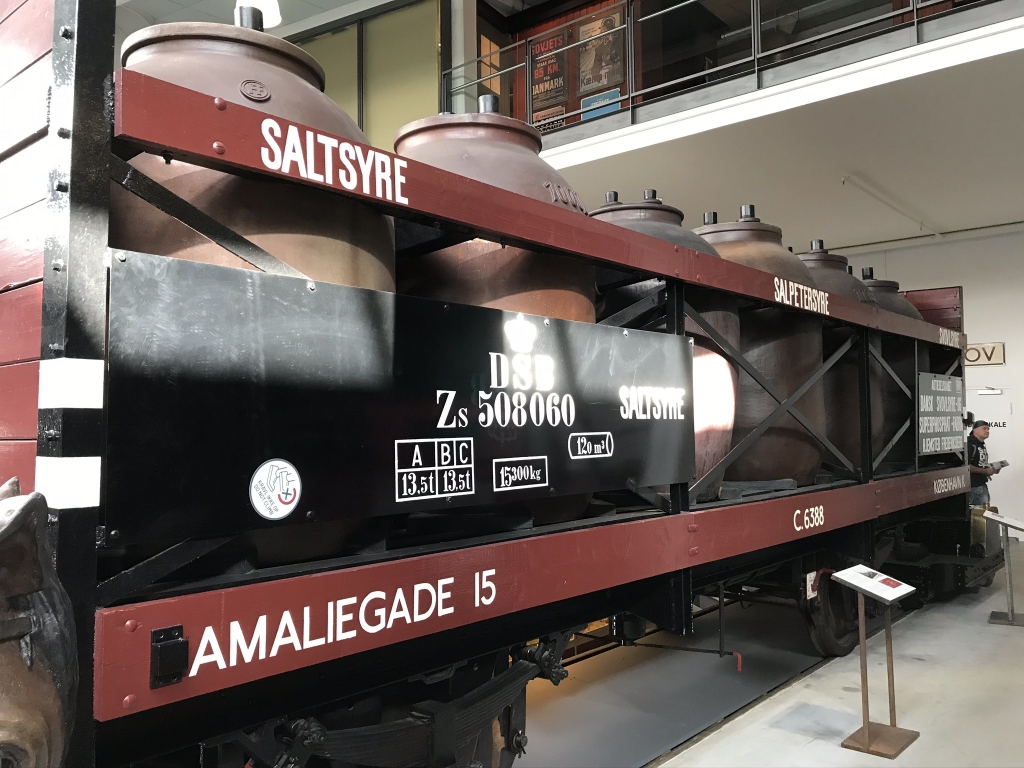
Those ceramic containers were made for transporting sulphuric acid, necessary for the production of fertilizer. Players of the Railroad Tycoon video game series may recall that fertilizer was a profitable commodity. The containers had to be made of ceramic, because the acid would eat through anything else. This type of car debuted in 1906 and was used until the 1960s.
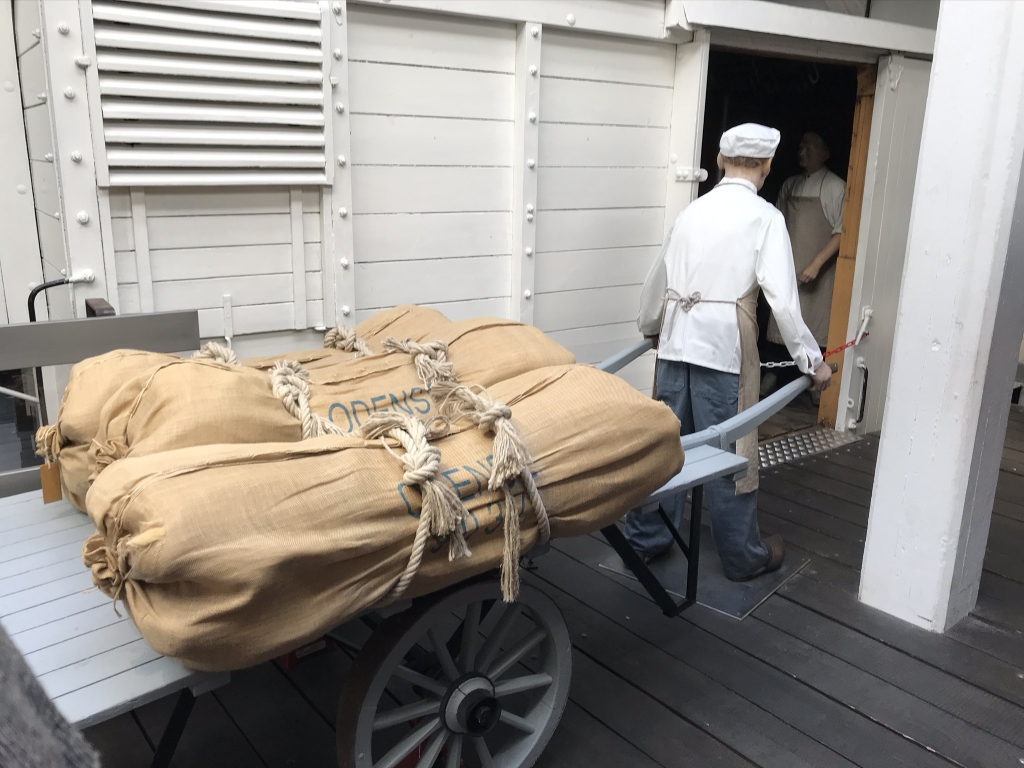
They're loading bacon onto this car, which would transport it to the port of Esbjerg to be loaded onto a ship bound for the UK. The British considered Danish bacon to be the best, and so the UK has long been a huge export market for it. Shipping it by rail ended in 1970, though, when the trains were replaced with refrigerated containers on trucks.
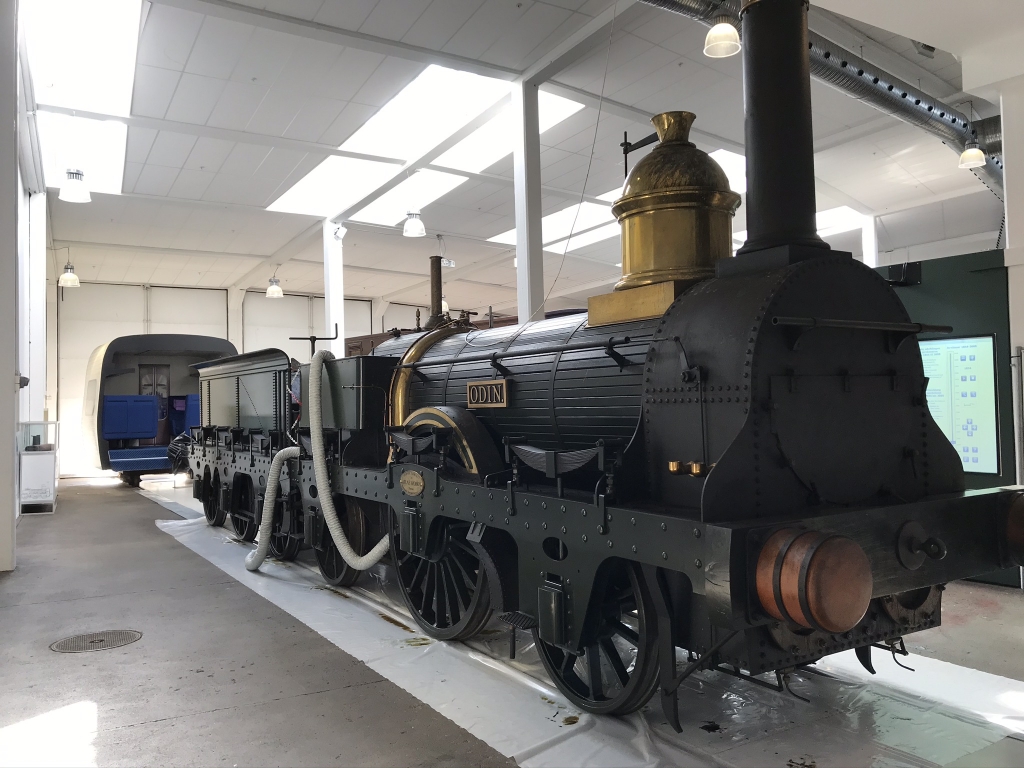
Odin was Denmark's first locomotive. It was scrapped over a century ago, so what you see here is a reconstruction.
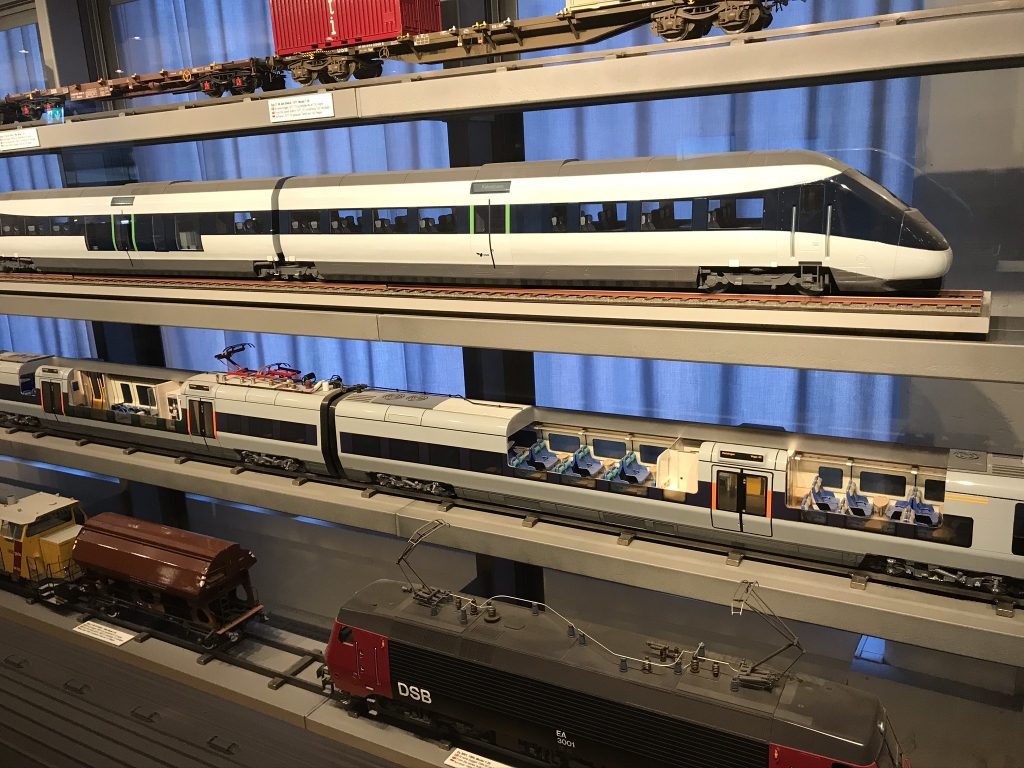
Some models of Danish trains that are currently in use. The second from the top is a high-speed train. Sadly I never had the chance to ride one; the three Danish trains I rode (Hamburg-Kolding, Kolding-Odense, and Odense-Copenhagen) were the slower, conventional, Intercity variety, the model of which is underneath the high-speed here.
After spending the morning in the museum, I had lunch at the train station, at a restaurant called D‘Let. This was another buffet line where you can make your own salad, but unlike that place where I ate the day before, D'Let is self-service. Though there is one caveat: you must wear disposable clear plastic gloves when you are serving yourself from the buffet.
At 12:57 my train departed Odense, and I would be riding to the end of the line at Copenhagen...
Other articles in this series:
- A Weekend in the Ruhr
- A Night in Odense and a Railway Museum
- Two Days in Copenhagen
- Passing through Gothenburg
- Ending the Trip in Kiel and Hamburg
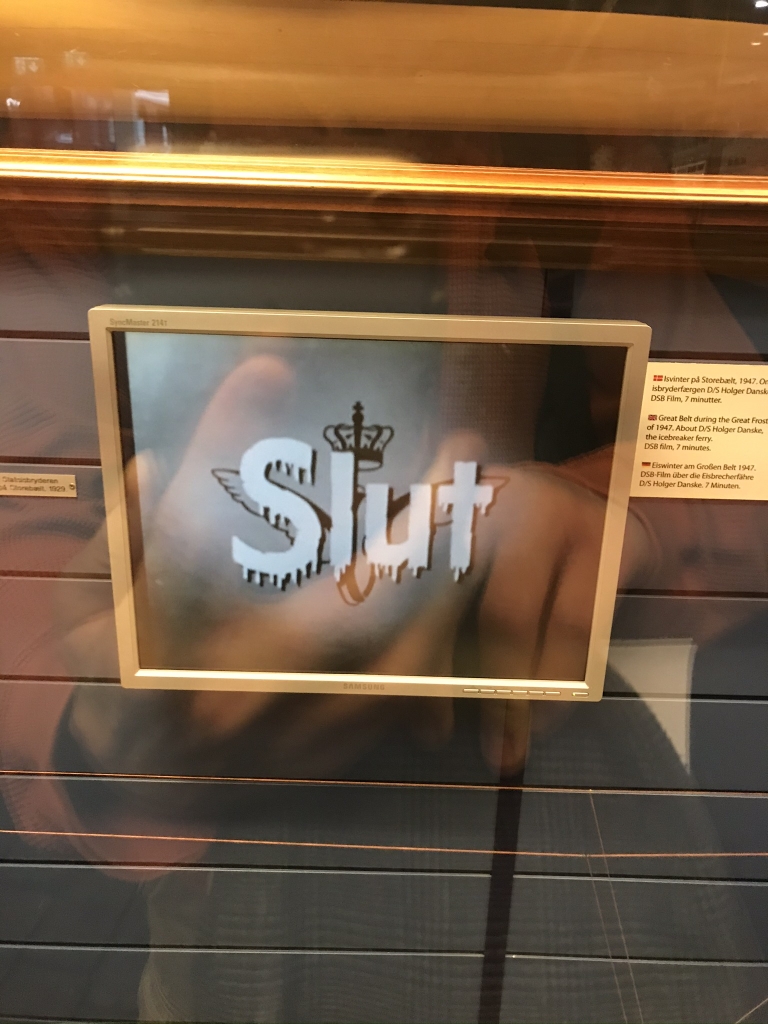
(It means "end," y'all)

